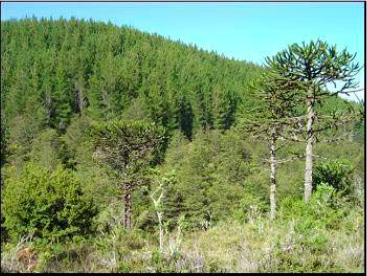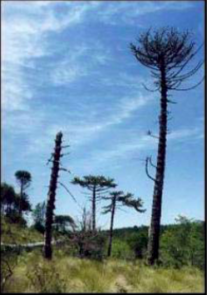Overview
The Villa Las Araucarias forest restoration project was undertaken in the Nahuelbuta Mountains of Chile’s Region IX to restore several hectares of threatened Araucaria araucana forest. Exotic species plantations of Pinus radiata, together with livestock grazing and agricultural disturbances, have reduced these forests to a fraction of their original size and have left only isolated stands of the rare and endemic A. araucana. In collaboration with local landowners and community members, project managers chose four sites for restoration and helped establish a small, community-run nursery to provide seedlings for the effort. The revegetation of project sites was accomplished through both direct seeding and seedling transplantation, and results thus far suggest higher rates of success for the transplanted plots. This has left participants feeling optimistic about the possibilities for managing a community-run nursery to further restoration and conservation efforts in the area.
Quick Facts
Project Location:
S-422, Saavedra, Región de la Araucanía, Chile, -38.7762298008945, -73.32811470234373
Geographic Region:
Latin America
Country or Territory:
Chile
Biome:
Temperate Forest
Ecosystem:
Temperate Forest - Coniferous
Area being restored:
4.0 hectares
Organization Type:
Community Group
Location
Project Stage:
Implementation
Start Date:
1997-08-22
End Date:
2008-08-22
Primary Causes of Degradation
Agriculture & Livestock, FragmentationDegradation Description
A. araucana forests in the project area have been severely degraded by anthropogenic pressures, and in a period of just 50 years, the total area of these forests has decreased from 1000 ha to 50ha. Livestock grazing, soil disruption resulting from agricultural activities, and fires set for agricultural clearance have been important deleterious agents, but exotic-species plantations (mainly Pinus radiata) are becoming the primary cause of degradation. Nearly half the project area is covered by these mono-specific plantations (46.9%), such that A. araucana has been limited to small, fragmented stands and even isolated trees in many instances.
Reference Ecosystem Description
According to CONAF et al. (1999), the total area of A. araucana forest types in Chile is of 253,713.6 ha. Approximately, 97% of this area is situated in the Andean Range, and only 2.9% occurs in the Coastal Range. In the coast of the IXth region (where the present project is situated), a small proportion of the total area of A. araucana can be found (approx 1.3%).
Of these A. araucana forests in the Coastal Range, approximately 65.9% are situated on private property, and thus the State (SNASPE) protects only 34.1%. The lack of protection for these coastal forests is a cause for concern among conservationists and researchers, as they possess unique genetic characteristics not found in other stands of A. araucana.
Project Goals
To create a pilot restoration area for A. araucana and train local community members in the production of plants and the realization of restoration activities.
Monitoring
The project does not have a monitoring plan.
Stakeholders
Project activities were undertaken with the collaboration of local people from the Villa Las Araucarias community. The construction of a greenhouse, collection of seeds, plantation of A. araucana, installation of fencing, maintenance of project sites and control of access to the plots was all coordinated with the help and participation of these community members.
The project also afforded an opportunity for 9 university students to work directly with the community and gain experience in forest restoration, in hopes that they will help promote similar restoration initiatives in other parts of the rural sector.
As a result of negotiations done by project leaders, a network of public and private stakeholders has been created to coordinate in-situ conservation strategies for A. araucana forest in the project area. The network involves governmental institutions (e.g. the National Forest Service, the National Environmental Office, and the Agriculture Office), local communities, timber companies, and universities and is working together to identify future A. araucana conservation activities.
Description of Project Activities:
In the project area, four 1.0 ha permanent plots were established and enclosed with fencing to prevent the encroachment of cattle (one of the main threats to the A. araucana forests). Plots 1 and 4 were established in a mixed forest of Pinus radiata and A. araucana, while plots 2 and 3 were established in an A. araucana-Nothofagus dombeyi forest.
In January 2003, ten female A. araucana trees were identified by project researchers and local community members for cone collection. Each tree was labeled with correlative numbers in order to monitor the following characteristics: dbh (diameter at breast height), total height, canopy cover, health status, and number of cones. The age of each tree was then measured by extracting increment borers. A total of 50 cones (equivalent to 34 kg) were collected from the labeled trees in April 2003 with the collaboration of local people, representing a total of approximately 3,300 A. araucana seeds (corresponding to about 344 satisfactory seeds per kilogram).
By the end of March 2004, a total of 8,500 seeds had been collected from trees located in the project area, and a portion of these seeds were propagated in the new greenhouse built in Villa Las Araucarias during the next sowing season (July 2004). Owing to the particular genetic characteristics of the A. araucana population in the project area, 100 seeds were donated to the Arboretum of UACH to establish an ex-situ collections of threatened Chilean species. The rest of the seeds were used in diverse research investigations, including an analysis for an undergraduate thesis.
The number of seeds collected per kg was lower in 2004 than in 2003, due to an increase in the size of seeds collected in 2004. Similarly, cones harvested in 2004 were larger than those collected in 2003.
In April 2004, a 60 m2 greenhouse was built on the property of Mr. Antonio Allende, the leader of the Villa Las Araucarias community after an agreement between project leaders and Mr. Allende was signed in order to ensure the proper maintenance and production of plants. The main objectives of this greenhouse are: the propagation of A. araucana plants and other accompanying species which will be used for conservation and ecological restoration works in the project area; the involvement and training of local people in the techniques of propagation of A. araucana; and the sale of plants by the community to generate income for themselves. In addition to the involvement of Mr. Allende, three members of the community were trained in the construction of the greenhouse and the preparation of beds for sowing.
From the 3,000 seeds collected in March 2003, 2,000 seeds were stored at the Seed Laboratory of the Universidad Católica de Temuco (UCT). On the 30th of June 2003, these seeds were treated for stratification process in wet sand for 60 days. By the end of August 2003, these seeds were sown at the UCT's nursery, and their mean germination rate was 33% by January 2004.
Between August and September 2003, plantation of seedlings and direct sowing of seeds were carried out at three permanent plots established at Villa Las Araucarias in 1999. The plantation was conducted on two permanent plots (1 and 2) which exhibited two different levels of protection: a) 100 seedlings in plot 1 with side protection given by the canopy of remaining A. araucana and Nothofagus dombeyi trees, and b) 100 seedlings in open ground (i.e. without protection) in plot 2. Transplanted seedlings were two years old and were produced from seeds collected in the same area.
In the permanent plots 2 and 4, a total of 1,000 seeds were used for direct sowing in August 2003. In plot 2, one or two seeds were sown in each cup, and a total of 300 seeds were sown in sites with protection and 300 seeds in sites without protection. In plot 4, 400 seeds were sown with protection.
Ecological Outcomes Achieved
Eliminate existing threats to the ecosystem:
A low germination rate (2%) was recorded in the direct sowing survey of plot 4, and seeds of plot 2 did not germinate. This low germination was probably due to fungi attack. Plantation activities showed better results, however, and seedlings exhibited a very low mortality (16% of the 100 seedlings transplanted in plot 1 and 18% of the seedlings in plot 2). By the end of March 2004, 52% of the seedlings in plot 1 and 43% of the seedlings in plot 2 were considered healthy. In plot 1, seedling mortality began one month later than in plot 2, and this pattern of mortality is best explained by differences in the micro-site and canopy protection. Whereas plot 1 is characterized by a steep slope and protection from some remaining trees, plot 2 is a flat, open site.
Factors limiting recovery of the ecosystem:
Site conditions are very adverse due to the presence of thin soils and high rainfall, which causes an increase in the water table during winter. In summer, the low water availability and high temperatures may cause severe damage to the plants and affect their growth and survival. Owing to these extreme site conditions, it is important in the nursery phase to produce strong, resilient seedlings and thereby reduce the levels of mortality.
Socio-Economic & Community Outcomes Achieved
Key Lessons Learned
The restoration work conducted at Villa Las Araucarias has met with initial success, registering a low mortality rate in the first year. However, propagation techniques must be improved in order to ensure better establishment of plants at the site. Extreme conditions of drought and flood also need to be considered in the preparation and conditioning of nursery-reared plants for the project area. In this sense, further research and experimentation is needed in order to ensure the success of future restoration work.
Although direct sowing exhibited low germination rates, owing mainly to the soil restrictive conditions of the study area, this method should still be considered in the future as an option for restoring degraded A. araucana sites–particularly in very thin soils where plantations will not succeed. More research is needed to provide specific guidelines about the implementation of direct sowing as method for restoration.
Long-Term Management
Between August 2003 and February 2004, several meetings were held with some of the landowners whose properties have stands of A. araucana in order to enlist their help in the conservation of A. araucana habitats. Thus far, five landowners have signed formal agreements to protect A. araucana on their lands, and measures taken under this project affected two of the five properties under agreement. Future activities should include restoration work on the other three properties. One of the five owners under agreement is a large forestry company that has expressed interest in working with project personnel and in obtaining plants from the new greenhouse for restoration activities elsewhere on its land. It has also agreed to develop conservation strategies for other threatened species occurring in the area (e.g. Berberidopsis coralline).
As a result of negotiations between project leaders and government representatives, an area of 5 ha owned by the State will soon be transferred to Villa Las Araucarias, enabling the local community to conserve and restore this area covered with a remnant A. araucana forest. Thus, future restoration activities have been identified as a continuing priority for this area.
In January 2004, Rainforest Concern (London, UK), under the coordination of the Universidad Austral de Chile (UACh) and Royal Botanic Garden Edinburgh (UK) staff, purchased 161.5 ha of A. araucana forests with the aim of ensuring their conservation. It is expected that the conservation area will be expanded to include neighboring areas as well, as an additional purchase was envisaged for May 2004.
Sources and Amounts of Funding
Funding for this project was provided by the UK’s Department of Environment, Food and Rural Affairs (DEFRA) and other donors.
Other Resources
Dr. Cristian Echeverría
[email protected]



